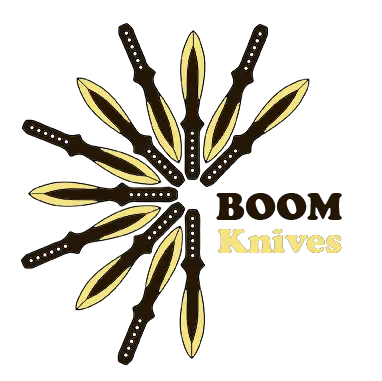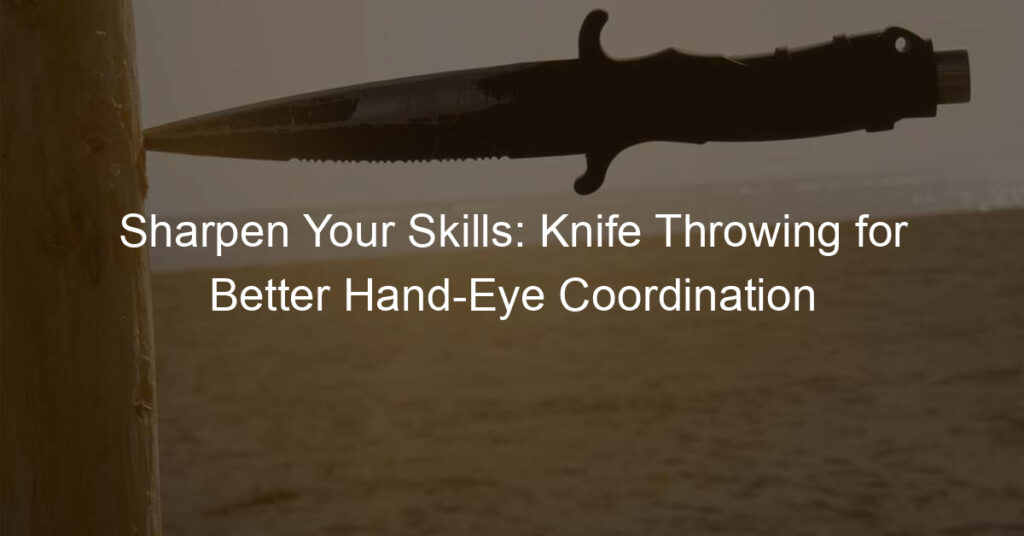Introduction to the Art of Knife Throwing
Knife throwing, an art that has been around for centuries, is more than just a thrilling hobby. It requires precision, focus, and a deep understanding of the basics. In this section, we will delve into the fundamentals of knife throwing and debunk some common myths and misconceptions.
-
- Understanding the Basics
Knife throwing is a skill that involves accurately propelling a knife to hit a target. It’s not about strength, but about technique and precision. The knife, which is specially designed for this purpose, should be held by the handle for a handle throw or by the blade for a blade throw. The distance between you and the target, the rotation of the knife, and your throwing technique all play a crucial role in successful knife throwing.
-
- Myths and Misconceptions
Many people believe that knife throwing is a dangerous sport reserved only for trained professionals. This is a myth. With proper safety measures and training, anyone can learn and enjoy this art. Another common misconception is that the heavier the knife, the better it is for throwing. In reality, the weight of the knife should be proportionate to the thrower’s strength and comfort.
History of Knife Throwing
-
- Origins and evolution
The art of knife throwing can be traced back to prehistoric times when early humans used thrown stones and later sharpened sticks as weapons for hunting. As civilizations advanced, so did their weapons. The knife, a tool used for various purposes, became a weapon of choice for many cultures. The practice of throwing knives for sport, entertainment, and martial arts began to evolve over time. In the 19th century, knife throwing became a popular sport in the United States, with the first recorded competition taking place in 1870. Today, knife throwing is practiced worldwide, with numerous competitions and organizations dedicated to the sport. [source]
-
- Significance in different cultures
For instance, in Native American cultures, knife throwing was a vital survival skill and a rite of passage for young warriors. In Japan, knife throwing, known as ‘Shurikenjutsu’, was a martial art practiced by the Samurai. In Africa, the Maasai warriors practiced knife throwing as a part of their warrior training. In Europe, knife throwing was a popular form of entertainment in circuses and fairs. These cultural practices have greatly influenced the development and popularity of knife throwing as a sport today. [source]
Understanding the history of knife throwing not only provides insight into the sport’s rich past but also helps us appreciate the skill and precision it requires. Whether you’re a seasoned thrower or a beginner, the history of knife throwing is a testament to the enduring appeal of this challenging and rewarding sport.
Knife Throwing Techniques
Basic Techniques
- Overhand ThrowThe most common technique used in knife throwing. It involves holding the knife by the handle and throwing it over your shoulder in a smooth, fluid motion. This technique allows for great control and accuracy. It’s perfect for beginners as it’s easy to learn and can be used with most types of throwing knives.
- Underhand ThrowA less common technique, but it’s very useful in certain situations. It involves holding the knife by the handle and throwing it under your shoulder. This technique can be a bit more challenging to master, but it allows for a quick and stealthy throw, making it ideal for close-range targets.
- Sidearm ThrowIt involves holding the knife by the handle and throwing it from your side in a horizontal motion. This technique allows for a quick release and can be very effective when used correctly.
Advanced Techniques
-
- Spin Throwing
A popular advanced technique in the world of knife throwing. It involves the knife making a full rotation or multiple rotations in the air before hitting the target. The key to mastering spin throwing is understanding the relationship between the distance to the target and the number of spins a knife needs to make. For example, a knife usually makes a full rotation every 3 meters. Therefore, if the target is 6 meters away, the knife needs to make two full spins before hitting the target.
-
- No-Spin Throwing
Involves the knife flying straight towards the target without spinning. This technique is more challenging to master but can lead to more accurate throws. The key to no-spin throwing is the grip. The knife should be held by the handle with the thumb on one side and the index and middle fingers on the other. The thrower then uses a flicking motion to propel the knife towards the target without causing it to spin.
-
- Instinctive Throwing
It involves throwing the knife without consciously calculating the distance or spin. Instead, the thrower relies on their instinct and experience. This technique is similar to how a baseball player might throw a ball to a teammate without consciously calculating the distance or angle. It requires a lot of practice, but once mastered, it can lead to incredibly accurate and fast throws.
Precision in Knife Throwing
- Importance of Precision
A precise throw means the knife lands exactly where you want it to, reducing the risk of accidents. Second, precision is essential for scoring in competitive knife throwing. The closer your knife lands to the center of the target, the higher your score. Lastly, precision enhances your overall technique, making you a better knife thrower. Wikipedia offers a comprehensive guide on the importance of precision in knife throwing.
- Techniques to Improve Precision
-
- Consistent Grip: Hold the knife the same way each time you throw it. This consistency can help improve your accuracy.
- Focus on the Target: Keep your eye on the target throughout the throw. This helps guide your hand and improve your aim.
- Practice Regularly: Like any skill, regular practice is key to improving precision in knife throwing.
-
- Common Mistakes Affecting Precision
- Incorrect Grip: Holding the knife incorrectly can affect your throw and reduce your precision.
- Lack of Focus: Not focusing on the target can lead to inaccurate throws.
- Insufficient Practice: Without regular practice, it’s difficult to improve precision and maintain consistency in your throws.
Knife Throwing Training
Physical Training
-
- Strength Training
It helps in building the arm, shoulder, and core muscles, which are essential for the throwing motion. A strong thrower can throw a knife with more force and accuracy. Strength training exercises like push-ups, pull-ups, and weight lifting can be beneficial. It’s not about lifting the heaviest weights, but about improving your strength gradually and consistently.
-
- Flexibility Training
It helps to improve the range of motion of your joints, allowing you to make smooth and precise throws. Flexibility training exercises like stretching, yoga, and Pilates can help improve your flexibility. It’s important to start slow and gradually increase your flexibility over time. Warm up before starting your flexibility training to prevent injuries.
Mental Training
-
- Focusing Techniques
-
-
- Deep Breathing: Deep breathing helps to calm the mind and improve concentration. Try taking slow, deep breaths before you throw the knife.
- Mental Imagery: Visualize the knife hitting the target. This can help you focus and improve your accuracy.
- Mindfulness: Stay in the moment. Don’t think about the past or the future. Concentrate on what you’re doing right now.
- Overcoming Fear and Anxiety
-
-
- Positive Self-Talk: Remind yourself that you can do it. Positive self-talk can boost your confidence and reduce anxiety.
- Practice: The more you practice, the more comfortable you’ll become.
- Relaxation Techniques: Try techniques like deep breathing and progressive muscle relaxation to reduce anxiety.
Knife Throwing Safety
-
- Safety Equipment
This includes protective eyewear to shield your eyes from any potential flying debris and sturdy gloves to protect your hands. Additionally, a good pair of shoes with non-slip soles can help prevent slips and falls. Safety should always be your top priority.
-
- Safe Practices
Always throw knives in a designated area, away from people and pets. Make sure your target is sturdy and placed against a safe backdrop to prevent any ricochets. Keep your throwing area clean and free of any obstacles that could cause accidents. And most importantly, never throw a knife towards another person.
-
- First Aid and Emergency Procedures
Therefore, knowing basic first aid and emergency procedures is essential. Always have a first aid kit nearby when practicing knife throwing. This should include bandages, antiseptic wipes, and a tourniquet. In case of a serious injury, call emergency services immediately.
Professional Knife Throwing
Competitive Knife Throwing
-
- Major Competitions and Tournaments
These include the World Championship Knife Throwing Competition, the European Throwing Meeting, and the International Knife Throwers Hall of Fame Championships. These events attract participants from all over the globe, each aiming to showcase their knife throwing skills and win prestigious titles. For more information on these competitions, you can visit their official websites or Wikipedia.
-
- Rules and Regulations
These rules vary from one competition to another but generally include guidelines on the type of knives that can be used, the distance from the target, and the scoring system. For instance, in most competitions, the knife must stick into the target for the throw to count. Also, the knife must make at least one complete rotation before hitting the target. To learn more about the rules of knife throwing, you can refer to the official rulebooks of the various competitions or check out this Wikipedia page.
Competitive knife throwing is a sport that requires discipline, patience, and a lot of practice. Whether you’re a beginner looking to get started or a seasoned pro aiming to improve your skills, understanding the major competitions and the rules that govern them is crucial to your success in this sport.
Career in Knife Throwing
-
- Opportunities and challenges
One of the biggest opportunities in a knife throwing career is the chance to participate in various competitions and tournaments, both nationally and internationally. These events not only provide a platform to showcase your skills but also offer substantial prize money. Furthermore, you can also become a trainer or coach, teaching others the art of knife throwing.
However, the path to a successful career in knife throwing is not without its challenges. It requires immense dedication, patience, and practice. The risk of injury is also a significant concern. Therefore, it is essential to take proper safety measures and use the right equipment.
-
- Profiles of successful professionals
For instance, Adam Celadin, a five-time World Champion in knife throwing, has become a well-known figure in this field. His journey is an inspiration for many aspiring knife throwers. He started his career in knife throwing at a young age and, with his dedication and hard work, has achieved great success.
Another notable professional is Melanie Kramer, a renowned knife thrower and trainer. She has won several championships and is known for her precision and technique. Her success story serves as a motivation for those who wish to pursue a career in knife throwing.
Knife Throwing Equipment
Types of Throwing Knives
- Balance Knives: These knives have a balance point in the middle, making them suitable for both handle and blade throwing techniques. An example is the Bowie knife.
- Blade-Heavy Knives: These knives have more weight towards the blade, making them ideal for blade throwing techniques. The Kukri knife is a popular blade-heavy knife.
- Handle-Heavy Knives: These knives have more weight towards the handle, making them perfect for handle throwing techniques. The Tanto knife is a well-known handle-heavy knife.
Maintenance and Care
- Cleaning: After each use, clean your knives with a soft cloth to remove any dirt or residue. This helps prevent rust and keeps the blade sharp.
- Storage: Store your knives in a dry place away from moisture to prevent rusting. A knife sheath or case can provide extra protection.
- Sharpening: Regularly sharpen your knives to maintain their edge. Use a sharpening stone or a professional knife sharpener for this purpose.
Knife Throwing Tips
- Tips for beginners
-
- Choose the right knife: A good throwing knife should be balanced and not too heavy. It should also be made of a durable material like stainless steel. You can read more about choosing the right knife here.
- Practice your grip: Holding the knife correctly is crucial. The handle should rest in the palm of your hand, and your fingers should wrap around it securely.
- Start close: Begin by standing close to the target, about 8-10 feet away. As you get more comfortable, you can gradually increase the distance.
- Follow through: When you throw the knife, make sure to follow through with your arm motion. This will help ensure the knife travels straight and hits the target.
-
- Tips for advanced throwers
- Experiment with different throws: Once you’ve mastered the basic throw, try experimenting with different techniques, such as the spin throw or the no-spin throw.
- Focus on accuracy: It’s not just about hitting the target, but hitting the exact spot you’re aiming for. Practice your aim to improve your accuracy.
- Try different knives: Different knives have different balances and weights, which can affect how they fly. Try throwing different types of knives to see which ones you prefer.
- Compete: Participating in competitions can be a great way to challenge yourself and learn from other throwers. You can find a list of upcoming competitions here.
Conclusion
- Recap of key points: We’ve delved into the fascinating world of knife throwing, covering its rich history, various techniques, and the importance of precision. We’ve also discussed the necessary training and safety measures, the role of professional knife throwing, and the essential equipment needed. Lastly, we’ve shared some valuable tips to improve your knife throwing skills.
- Encouragement for continued practice: Like any other skill, knife throwing requires consistent practice and dedication. Don’t be discouraged if you don’t get it right at first. Keep practicing, stay safe, and you’ll see improvement over time. The world of knife throwing is vast and exciting, and there’s always something new to learn.







